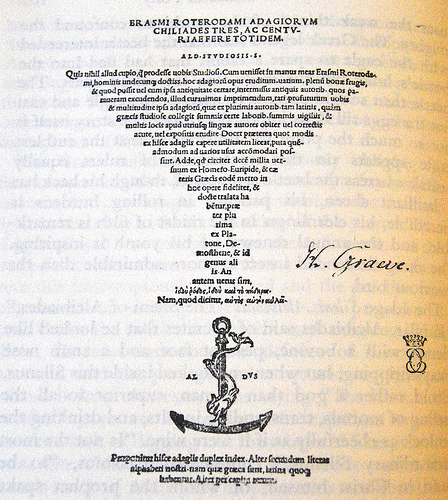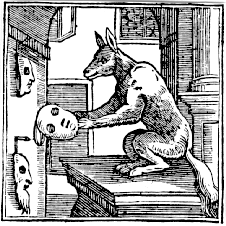|
The Fox And The Mask
The Fox and the Mask is one of Aesop's Fables, of which there are both Greek and Latin variants. It is numbered 27 in the Perry Index. A fable for the empty-headed The fable is always briefly stated and seems chiefly the vehicle for a criticism of the good-looking but stupid upper class. A fox comes across a mask anciently used by actors; after an examination, it remarks, 'So full of beauty, so empty of brains!' The Latin version of this, generally shortened to ''caput vacuum cerebro'', then became proverbial. It is recorded by Erasmus in his ''Adagia'', along with its Greek equivalent (Ὦ οἷα κεφαλὴ, καὶ ἐγκέφαλον ούκ ἔχει), with the explanation that it originates from Aesop's fable. There are different versions of the story, sometimes involving a wolf contemplating the broken head of a statue. Its earliest English appearance is in William Caxton's collection of the fables (1484), under the title of "The wulf and the dede man’s hede”, as an e ... [...More Info...] [...Related Items...] OR: [Wikipedia] [Google] [Baidu] |
Aesop's Fables
Aesop's Fables, or the Aesopica, is a collection of fables credited to Aesop, a slave and storyteller believed to have lived in ancient Greece between 620 and 564 BCE. Of diverse origins, the stories associated with his name have descended to modern times through a number of sources and continue to be reinterpreted in different verbal registers and in popular as well as artistic media. The fables originally belonged to oral tradition and were not collected for some three centuries after Aesop's death. By that time, a variety of other stories, jokes and proverbs were being ascribed to him, although some of that material was from sources earlier than him or came from beyond the Greek cultural sphere. The process of inclusion has continued until the present, with some of the fables unrecorded before the Late Middle Ages and others arriving from outside Europe. The process is continuous and new stories are still being added to the Aesop corpus, even when they are demonstrably more ... [...More Info...] [...Related Items...] OR: [Wikipedia] [Google] [Baidu] |
Perry Index
The Perry Index is a widely used index of "Aesop's Fables" or "Aesopica", the fables credited to Aesop, the storyteller who lived in ancient Greece between 620 and 560 BC. The index was created by Ben Edwin Perry, a professor of classics at the University of Illinois Urbana-Champaign. Modern scholarship takes the view that Aesop probably did not compose all of the fables attributed to him;D. L. Ashliman, “Introduction,” in George Stade (Consulting Editorial Director), ''Aesop’s Fables.'' New York: Barnes & Noble Classics, (2005). Produced and published in conjunction with Fine Creative Media, Inc. (New York) Michael J. Fine, President and Publisher. See pp. xiii–xv and xxv–xxvi. indeed, a few are known to have first been used before Aesop lived, while the first record we have of many others is from well over a millennium after his time. Traditionally, Aesop's fables were arranged alphabetically, which is not helpful to the reader. Perry listed them by language (Greek ... [...More Info...] [...Related Items...] OR: [Wikipedia] [Google] [Baidu] |
Erasmus
Desiderius Erasmus Roterodamus (; ; English: Erasmus of Rotterdam or Erasmus;''Erasmus'' was his baptismal name, given after St. Erasmus of Formiae. ''Desiderius'' was an adopted additional name, which he used from 1496. The ''Roterodamus'' was a scholarly name meaning "from Rotterdam", though the Latin genitive would be . 28 October 1466 – 12 July 1536) was a Dutch philosopher and Catholic theologian who is considered one of the greatest scholars of the northern Renaissance.Gleason, John B. "The Birth Dates of John Colet and Erasmus of Rotterdam: Fresh Documentary Evidence", Renaissance Quarterly, The University of Chicago Press on behalf of the Renaissance Society of America, Vol. 32, No. 1 (Spring, 1979), pp. 73–76www.jstor.org/ref> As a Catholic priest, he was an important figure in classical scholarship who wrote in a pure Latin style. Among humanists he was given the sobriquet "Prince of the Humanists", and has been called "the crowning glory of the Christian humanists ... [...More Info...] [...Related Items...] OR: [Wikipedia] [Google] [Baidu] |
Adagia
''Adagia'' (singular ''adagium'') is the title of an annotated collection of Greek and Latin proverbs, compiled during the Renaissance by Dutch humanist Desiderius Erasmus Roterodamus. Erasmus' collection of proverbs is "one of the most monumental ... ever assembled" (Speroni, 1964, p. 1). The first edition, titled ''Collectanea Adagiorum'', was published in Paris in 1500, in a slim quarto of around eight hundred entries. By 1508, after his stay in Italy, Erasmus had expanded the collection (now called ''Adagiorum chiliades tres'' or "Three thousands of proverbs") to over 3,000 items, many accompanied by richly annotated commentaries, some of which were brief essays on political and moral topics. The work continued to expand right up to the author's death in 1536 (to a final total of 4,151 entries), confirming the fruit of Erasmus' vast reading in ancient literature. Commonplace examples from ''Adagia'' Some of the adages have become commonplace in many European language ... [...More Info...] [...Related Items...] OR: [Wikipedia] [Google] [Baidu] |
Francisco Rodríguez Adrados
Francisco Rodríguez Adrados (29 March 192221 July 2020) was a Spanish Hellenist, linguist and translator. He worked most of his career at the Complutense University of Madrid. He was a member of the Real Academia Española and Real Academia de la Historia. Life Rodríguez Adrados was born on 29 March 1922 in Salamanca. He studied classical philology at the University of Salamanca, where he obtained a degree in 1944. He later obtained a doctorate in classical philology from the Complutense University of Madrid. Rodríguez Adrados became a teacher of Greek at the Instituto Cardenal Cisneros in Madrid in 1949. Two years later, he became a professor at the University of Barcelona and the next year, he moved to the Complutense University of Madrid, where he worked until his retirement. He worked as a translator of Ancient Greek and Sanskrit texts. He was considered to be an expert on Ancient Greek. Rodríguez Adrados died on 21 July 2020 in Madrid, aged 98. Awards and honors For ... [...More Info...] [...Related Items...] OR: [Wikipedia] [Google] [Baidu] |
William Caxton
William Caxton ( – ) was an English merchant, diplomat and writer. He is thought to be the first person to introduce a printing press into England, in 1476, and as a printer (publisher), printer to be the first English retailer of printed books. His parentage and date of birth are not known for certain, but he may have been born between 1415 and 1424, perhaps in the Weald or wood land of Kent, perhaps in Hadlow or Tenterden. In 1438 he was apprenticed to Robert Large, a wealthy London silk Mercery, mercer. Shortly after Large's death, Caxton moved to Bruges, Belgium, a wealthy cultured city in which he was settled by 1450. Successful in business, he became governor of the Company of Merchant Adventurers of London; on his business travels, he observed the new printing industry in Cologne, which led him to start a printing press in Bruges in collaboration with Colard Mansion. When Margaret of York, sister of Edward IV, married the Charles the Bold, Duke of Burgundy, they moved ... [...More Info...] [...Related Items...] OR: [Wikipedia] [Google] [Baidu] |
Andrea Alciato
Andrea Alciato (8 May 149212 January 1550), commonly known as Alciati (Andreas Alciatus), was an Italian jurist and writer. He is regarded as the founder of the French school of legal humanists. Biography Alciati was born in Alzate Brianza, near Milan, and settled in France in the early 16th century. He displayed great literary skill in his exposition of the laws, and was one of the first to interpret the civil law by the history, languages and literature of antiquity, and to substitute original research for the servile interpretations of the glossators. He published many legal works, and some annotations on Tacitus and accumulated a sylloge of Roman inscriptions from Milan and its territories, as part of his preparation for his history of Milan, written in 1504–05. Among his several appointments, Alciati taught Law at the University of Bourges between 1529 and 1535. It was Guillaume Budé who encouraged the call to Bourges at the time. Pierre Bayle, in his General Dictiona ... [...More Info...] [...Related Items...] OR: [Wikipedia] [Google] [Baidu] |
Emblem Book
An emblem book is a book collecting emblems (allegorical illustrations) with accompanying explanatory text, typically morals or poems. This category of books was popular in Europe during the 16th and 17th centuries. Emblem books are collections of sets of three elements: an icon or image, a motto, and text explaining the connection between the image and motto. The text ranged in length from a few lines of verse to pages of prose. Emblem books descended from medieval bestiaries that explained the importance of animals, proverbs, and fables. In fact, writers often drew inspiration from Greek and Roman sources such as Aesop's Fables and Plutarch's Lives. Definition Scholars differ on the key question of whether the actual emblems in question are the visual images, the accompanying texts, or the combination of the two. This is understandable, given that first emblem book, the ''Emblemata'' of Andrea Alciato, was first issued in an unauthorized edition in which the woodcuts were ... [...More Info...] [...Related Items...] OR: [Wikipedia] [Google] [Baidu] |

_-_Foto_G._Dall'Orto_5_ago_2006.jpg)
.jpg)



